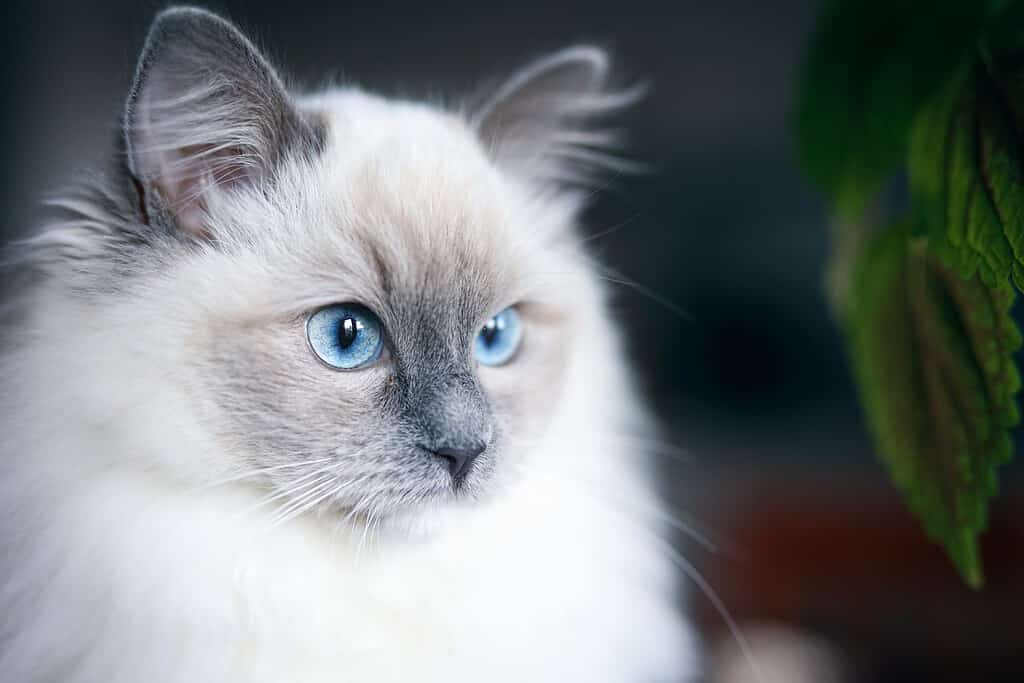It’s no secret that ragdoll cats are some of the most lovable and loyal companions out there. If you’re set on adding one of these cats to your family, how can you decide which gender to adopt? Although all ragdolls have general personality traits that either gender will display to some degree, each gender has their own quirks as well. Today, we discuss five differences between male and female ragdolls to help you decide which one is a better fit for your home.
Ragdolls: A Brief History

All ragdolls have piercing blue eyes.
©oussama el biad/Shutterstock.com
Compared to other cat breeds, ragdolls have only very recently been developed. Breeds like the Russian blue and the Siamese date back well over a century, whereas ragdolls only just appeared during the 1960s. During this time, a woman named Ann Baker developed the breed from a street cat named Josephine. Although she was apparently of no particular breed, many people say that she resembled a white angora. Josephine’s kittens became the first ragdolls, and over the course of many years, Ann continued to develop the breed.
Josephine’s kittens had unique markings, and today we have come to know them as mitted, colorpoint, and bicolor. In addition to their beautiful looks, her kittens had a sweet disposition and made excellent house pets. These qualities still remain true today. Ragdolls as a whole usually get along well with other animals and small children due to their relaxed personality. Although this breed is infinitely loving to their immediate families, they may be slower to warm up to strangers.
Physical Characteristics

On average, ragdolls will live to be between 12 and 15 years, but many live into their 20s.
©Peredniankina/Shutterstock.com
It’s no secret that ragdolls are one of the largest cat breeds available. Most people say that the ragdoll is only second in size to the incredible Maine coon, and it’s hard to disagree. However, between male and female ragdolls, males will be the larger of the two. Males will usually grow to be between 13 and 18 pounds, whereas females will only weigh between 10 and 15 pounds. Males will also grow to be slightly taller, and their bodies will be more muscular and sturdier.
Vocalizations
Both male and female ragdolls tend to be a little chatty. These cats know how to get what they want, and if that means meowing for your attention, that’s what they’ll do! Although males and females are somewhat equally vocal, they are less so than other cat breeds. Ragdolls will meow when they’re excited, when they’re hungry, or when they want their owner’s attention. Males tend to be a little less vocal than females. This is especially true if your female is not spayed, as they tend to meow much more when they’re in heat.
Behavioral Differences

The cost of a ragdoll depends on several factors, such as their pedigree and coloration.
©Ria Peene/Shutterstock.com
Although all ragdolls have friendly, dog-like personalities, there are slight differences in behavior between the genders. Male ragdolls are the more social of the two genders, and they are the type to follow their owners around from room to room. They are more likely to be “lap cats,” and are often content to spend their days curled up on the couch with their humans. On the other hand, females can be a little more aloof. They’re equally as loving, but they don’t seek out attention as frequently as males. On the other hand, they might be slightly moodier, especially if they’re left intact.
Response to Training
Although training cats isn’t discussed as often as training dogs, it’s still very possible, especially for a breed like the ragdoll. These cats are naturally intelligent and driven to please their owners, so training them should be relatively easy. Females tend to be more attentive, and it’s generally easier to keep them engaged in the lesson. Males may be more excitable and distracted, so clicker training and using treats as motivation may prove useful.
Health Considerations for Ragdolls Depending on Their Gender

Ragdolls are universally known as one of the most “dog-like” cats.
©Irene Miller/Shutterstock.com
As with any animal, ragdolls will be more susceptible to certain diseases based on their gender. Ovarian and testicular cancers are concerns for ragdolls who are left intact. If your cat isn’t being used for breeding, it is highly encouraged that you spay or neuter them respectively. Undergoing these procedures greatly decreases the chance that they will develop these conditions. All ragdolls will be somewhat vulnerable to dental issues, eye disease, and obesity. Talk to your vet about your individual cat’s needs.
Final Thoughts
Ragdolls are loving cats with a wealth of wonderful qualities. Which gender you choose doesn’t make a huge difference at the end of the day. The distinctions in their personalities are only slight, and many owners won’t be greatly impacted by them. As always, there are exceptions to these generalizations, and some ragdolls can completely embody the characteristics of the opposite gender. Regardless of the gender you choose, you can certainly expect many years of companionship and happiness!
The photo featured at the top of this post is © Irene Miller/Shutterstock.com
Thank you for reading! Have some feedback for us? Contact the AZ Animals editorial team.






